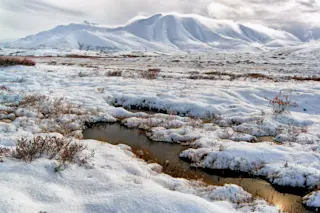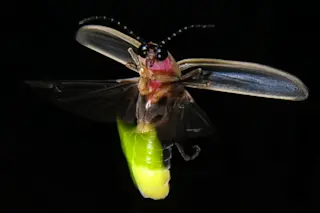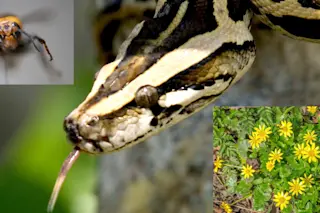When Larry Madin first became aware of parasites in the open ocean, he was a graduate student living in a sort of scientists’ commune in the Bahamas. It was a large, unfinished house on Bimini, with plywood floors and bare holes for windows and one bathroom for the one or two dozen biologists, spouses, and children who lived there. It was an interesting experience, says Madin. Fortunately we were all young. The expedition had been organized by Madin’s adviser at the University of California at Davis, an ornithologist turned marine biologist named Bill Hamner. Hamner got his students to live on fish and rice and in close quarters for a year with the understanding that they were doing something new--scientifically new. From Bimini they could take a small boat just half a mile offshore and scuba dive in the Gulf Stream every day. They could watch the gelatinous animals that floated there the way Konrad Lorenz had watched birds, the way Jane Goodall had watched chimps. They could do jelly ethology, which no one had ever done. This was in 1971 and 1972. Madin spent that year watching little jelly barrels called salps, each a few inches long, and among the things he noticed was that they often carried a freight of even smaller crustaceans as parasites.
In the summer of 1972, Richard Harbison was getting to know jellies, too, and sailing away from a career in biochemistry on a research vessel belonging to the Woods Hole Oceanographic Institution. On hot days in the middle of the Atlantic, Harbison jumped off the ship with other members of the crew: swim call. Unlike most people, Harbison did not need to be told that the ocean is filled with gelatinous animals that are as unrelated to medusas, the true jellyfish, as we are--things like salps, for instance, which belong to our own phylum, the chordates. Harbison had been interested in salps since college. I don’t know why--just because they’re weird, he says. Jumping off the ship, he got a chance to swim with them, and to notice that they often seemed to be dotted with crustaceans, some a half-inch in size, some much smaller. Later he also got to put in to Lisbon, an entertaining port. I said to myself, ‘This is a hell of a lot better than being in a lab coat,’ he recalls. ‘This is really fun.’
A serious interest in salps gains you membership in a fairly small club, and so Madin soon moved to Woods Hole to work with Harbison. At Bimini, Madin had figured out how salps make a living. Moving and eating are the same thing for them. As water flows into one open end of the barrel, the barrel contracts, shooting the water out the back and pushing the salp forward. On its way, though, the water passes through an internal net of mucus, sort of like a sleeve lining, that strains out particles as small as bacteria. The net itself moves like a conveyor belt: it is continuously secreted near the front of the salp and continuously devoured, along with its content of food, at the back, where it is rolled into a fine strand and funneled into the salp’s esophagus. It’s a pretty slick system, almost industrial. Harbison likens salps to ramjets--jelly ramjets. On some days, in some parts of the ocean, it is possible to swim through a blizzard of salp feces.
Not surprising, then, given their feeding prowess in a food-poor environment, that salps should attract some hangers-on. When Madin and Harbison pooled their observations, they realized that they had both been looking at the same type of parasite. The crustaceans they’d been seeing were all amphipods, members of a numerous and vaguely shrimplike order (except that real shrimp belong to a different order altogether). More precisely, they belonged to a group called the hyperiids, most of which had been thought to be free-swimming--but all of which, Madin and Harbison discovered, seemed to depend on jellies in one way or another. A pregnant female of the genus Phronima eats the guts out of a salp, moves into the empty barrel, then lays her eggs there. Adult Lycaea nibble away at the insides of a salp; as long as they do not sever blood vessels or consume vital internal organs, the salp endures. The most refined parasites, though, are Vibilia: they sit at the salp’s esophagus, sometimes sticking their heads right down it, and divert some of its food into their own greedy mouths. The salp does not seem to mind.
Hyperiid amphipods invade other jellies too, burrowing into medusas, for instance, as well as into ctenophores. (Ctenophores are also called comb jellies, for the comblike rows of tiny paddles that propel them. They are a phylum unto themselves. The c is silent.) And amphipods are not the only kind of parasite. Harbison and Madin have seen crabs riding on salps and fish inside them. They have seen lobster larvae and shrimp hanging on to medusas. They have seen worms on and inside ctenophores. Diving all over the Atlantic in the 1970s and 1980s, into the top hundred feet with scuba gear and into deeper waters with submersibles, Harbison and Madin witnessed all manner of parasitic transactions. Many involved food and some involved transport. All of them involved place--a place to hide, to molt, to mate, to rear young, or just to rest. At the most basic level, that is what jellies offer: places, islands in space, for animals that are not as well-adapted as the jellies themselves are to a placeless world.
It is a world we can barely imagine, the interior of the ocean-- the only truly three-dimensional habitat on Earth; the only one without boundaries, save for the animals themselves; a moving world shot through with randomness. When you jump in the ocean, you never know what you’re going to see, says Harbison. Because the water is not the same water you jumped into yesterday. And living in the ocean, you don’t have the predictability that you do on land. On land you live in your house, you know what it looks like when you walk out the door--you’re always in the same place. We have a very good concept of place, and where we are makes a lot of difference to us. And it does to most terrestrial animals.
But if you’re a planktonic animal--your environment is constantly new. It’s as if you open your door tomorrow, and there is a big polar bear. And the next day you open your door, and out in the front yard is a Bengal tiger. And the next day there’s an anteater. I mean it’s that kind of environment, which is really hard for us to understand.
Floating is a sensible thing to do in a three-dimensional, food- poor world--it saves energy--and being 95 percent water and gelatinous is the best way to float. Being transparent makes sense because it makes you hard to see when you’re up in the sunlit water, and in the dark depths, where the sun’s withering ultraviolet doesn’t penetrate, who needs protective pigment anyway? Even being delicate and wispy, as so many jellies are, so delicate and wispy that they show up in oceanographers’ nets only as a formless mystery goo--that too makes sense, says Harbison, because all that sticky gelatin and mucus is the best way to collect food. And in the quiet waters beneath the waves, you don’t need a skeleton or even a shell to retain your integrity.
In short, jellies are the perfect expression of their environment. That explains why so many phyla--mollusks and chordates, cnidarians and ctenophores--have independently gone gelatinous when they colonized the open ocean. At some basic level--Harbison and Madin are far from understanding in any detail most of the parasitic relationships they witnessed--it also explains why so many animals that are not gelatinous, about a hundred species by Madin’s off-the-cuff estimate, have come to depend on jellies.
It’s all water out there, Madin says. Anything that’s solid, something else is going to land on it somehow, take advantage of it, live on it.
Neither Madin nor Harbison is exploring the ocean the way he used to, let alone studying a phenomenon so recondite as parasitism. They can’t get money to do that. Madin is participating in a government-funded project called globec, involving more than a hundred scientists, the goal of which is to determine how global climate change might affect the fishery on Georges Bank off Massachusetts--the same fishery that has lately been all but wiped out by overfishing. Harbison is mostly describing the animals he was able to collect in the late 1980s. Back then he and Madin were regularly diving in submersibles to 1,000 or 2,000 or 3,000 feet and finding new species on every cruise. So he has a lot to do.
But scarcely anyone is visiting that water today, below the surface of the open sea, watching the animals, figuring out how they live. These days the outside chance of finding a fossil bacterium on Mars is enough to generate tremendous enthusiasm--justifiable, to be sure--for billion-dollar missions of exploration to that planet. And yet we are content to pass over in complacency and almost total ignorance the largest and strangest habitat on Earth. It seems odd. It seems silly.
It’s sort of frustrating, says Harbison. Because there’s this wonderful, wonderful world down there, and it’s just so hard to get to. It’s an inaccessible place nobody ever goes to--so nobody cares, because nobody knows anything about it.
Going down and looking at jellies--it’s really, really basic when you think about it. What we need is the same thing that they had in the eighteenth and nineteenth centuries--exploration. It’s a dirty word now. We’re supposed to be hypothesis-testing. ‘We’re modern scientists, there’s no exploring left to do, we know everything in the world, and anything that we don’t know is not worth knowing.’ That’s the attitude. But I’m convinced that there’s so much that we don’t know about what’s on this planet--when we do know about it, it will change the way we think.














